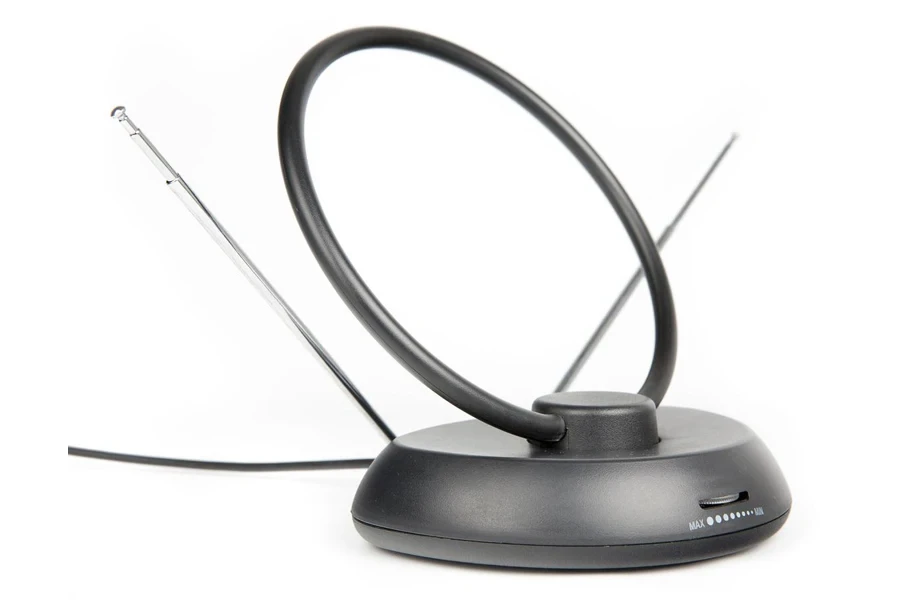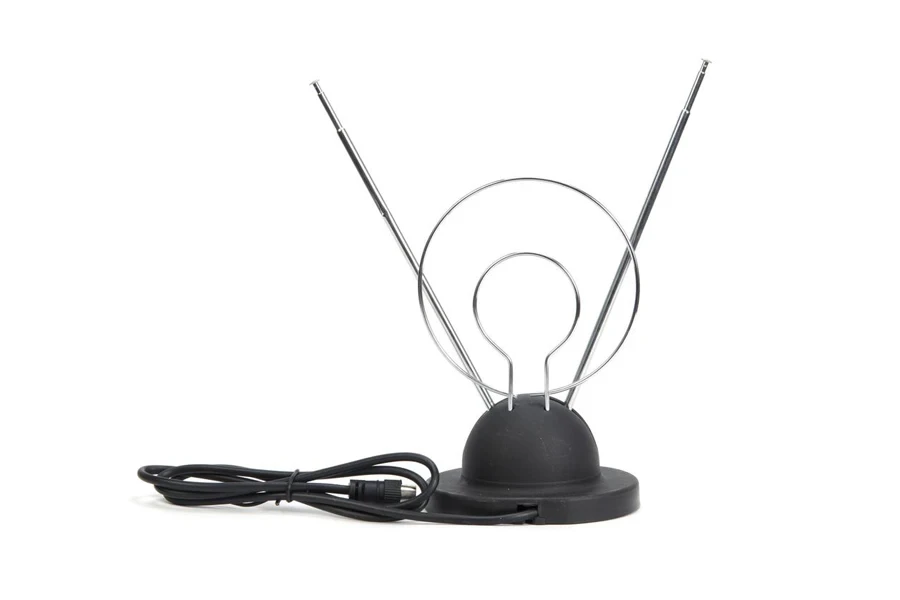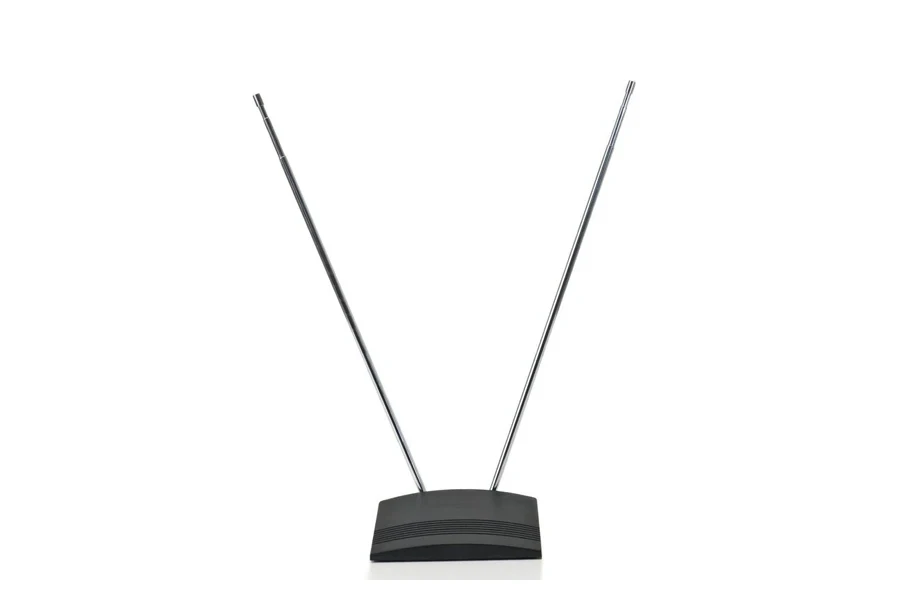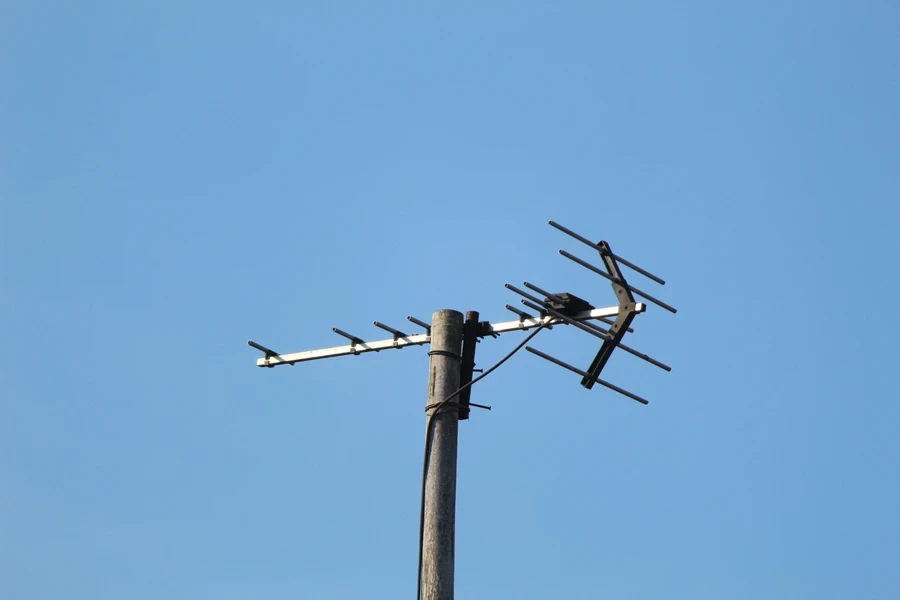The resurgence of TV antennas in 2024 has marked a significant shift in how television content is accessed, offering a cost-effective and high-quality alternative to traditional cable and streaming services. Modern TV antennas provide users with free access to a wide array of local and network channels, delivering crystal-clear HD picture quality. This trend is driven by the increasing desire to cut down on expensive cable bills while maintaining access to essential programming. By choosing the right TV antenna, users can enjoy reliable reception of news, sports, and entertainment without the need for costly subscriptions or contracts.
Table of Contents
1. Understanding TV Antennas: Types and Usage
2. Current Market Overview for TV Antennas
3. Key Considerations for Selecting TV Antennas
4. Leading TV Antenna Models in 2024
5. Conclusion
Understanding TV antennas: Types and usage

Indoor TV antennas
Indoor TV antennas are designed for use inside buildings, offering a convenient and easy solution for accessing television broadcasts. These antennas are typically compact, making them easy to install and move around as needed. They are best suited for urban environments where broadcast towers are relatively close, and signal strength is strong. For example, an indoor antenna like the Gesobyte Amplified HD Digital TV Antenna, with its 18ft coaxial cable, can be easily placed anywhere in a home to receive a clear signal. The compact design and simple installation process make indoor antennas a popular choice for those living in apartments or areas with minimal signal obstructions.
The primary advantage of indoor antennas is their ease of use. They often come with features like smart IC chips and signal amplifiers that enhance signal reception. However, these antennas may struggle in areas with significant signal interference from walls or electronic devices. Despite this, many modern indoor antennas are equipped with advanced technology to filter out unwanted signals, providing users with a stable and high-quality viewing experience.
Outdoor TV antennas
Outdoor TV antennas are designed for exterior installation, usually on rooftops or poles, to capture television signals more effectively. These antennas generally provide superior signal reception compared to indoor models, making them ideal for rural areas or locations with significant obstructions such as mountains or tall buildings. For instance, the Five Star Outdoor Digital Amplified HDTV Antenna is known for its ability to amplify signals effectively, even in challenging environments.
The benefits of outdoor antennas include higher signal strength and the ability to capture broadcasts from multiple directions. They are often built with durable materials to withstand various weather conditions, ensuring long-term reliability. Outdoor antennas can also be positioned at higher elevations, further improving their ability to receive clear signals. While the installation process can be more complex and time-consuming than indoor antennas, the enhanced reception quality makes them a worthwhile investment for those in areas with weaker signals.
Amplified vs. non-amplified antennas
Amplified antennas come with built-in signal boosters designed to enhance the reception of weak signals. These antennas are particularly beneficial in areas where broadcast signals are weak or subject to interference. An example is the Gesobyte Amplified HD Digital TV Antenna, which features a powerful amplifier and an intelligent switch control to optimize signal reception. The amplification technology helps in capturing more channels and improving the clarity of received broadcasts.
However, amplified antennas are not without their drawbacks. In areas with already strong signals, the amplification can sometimes result in noise and interference, potentially degrading the viewing experience. It’s essential to choose an amplified antenna only when necessary, as non-amplified antennas often suffice in locations with robust signal strength.
Non-amplified antennas, on the other hand, do not include signal boosters and rely solely on their design and placement to capture television broadcasts. These antennas are suitable for areas with strong, clear signals and less prone to the issues caused by over-amplification. They are generally simpler to install and maintain, making them a practical choice for users in urban settings or near broadcast towers. An example is the Channel Master Flatenna, which performs well without additional amplification in locations with direct line-of-sight to broadcast towers.
In conclusion, selecting the right type of TV antenna depends largely on the specific needs and conditions of the user’s location. Indoor antennas offer convenience and ease of use in urban areas, while outdoor antennas provide superior reception in rural or obstructed environments. The choice between amplified and non-amplified antennas should be based on the strength of the local signal and the potential for interference.
Current market overview for TV antennas

Market growth and trends
The TV antenna market has seen notable growth, driven by the increasing trend of cord-cutting as consumers seek cost-effective alternatives to cable subscriptions. Experts currently value the TV antenna market at approximately USD 3.8 billion, and it is projected to reach USD 5.4 billion by 2028, with a compound annual growth rate (CAGR) of 5.2% from 2023 to 2028. This growth is attributed to the affordability and technological advancements in modern antennas, which offer high-definition reception and a broad range of channels without ongoing costs.
The demand for TV antennas is also influenced by the trend towards sustainable and cost-effective home entertainment solutions. Advances in technology have led to improved antenna performance, including features such as signal amplification, smart IC chips, and multi-directional reception capabilities. These enhancements make TV antennas a more viable option for a broader audience. The market’s expansion is further supported by the increasing availability of high-quality indoor antennas, particularly in urban areas where space constraints and aesthetics are significant considerations.
Additionally, outdoor antennas remain popular in rural and suburban areas due to their superior signal reception capabilities. The continued development of durable, weather-resistant materials has made outdoor antennas a reliable choice for regions with challenging signal conditions. As a result, both indoor and outdoor antennas are experiencing steady demand growth.
Key players and brands
The TV antenna market is dominated by several key players recognized for their innovation and quality products. Leading brands such as Gesobyte, Mohu, and Antennas Direct have established themselves as market leaders, each offering a variety of antennas designed to meet diverse consumer needs.
Gesobyte is known for its advanced amplified HD digital TV antennas, which feature powerful signal boosters and intelligent IC chips. These products can capture a wide range of channels with exceptional clarity, positioning Gesobyte as a top choice among consumers seeking reliable performance and ease of use.
Mohu is another prominent player, famed for its innovative flat antennas like the Mohu Leaf. These antennas are celebrated for their simplicity, ease of installation, and strong performance in various environments. Mohu has been instrumental in promoting cord-cutting solutions, offering products that cater to different usage scenarios and signal reception requirements.
Antennas Direct has also made a significant impact on the market with its high-performance antennas. The company’s ClearStream series is highly regarded for delivering superior reception over long distances. Antennas Direct’s commitment to quality and customer satisfaction has helped maintain a strong presence in the competitive TV antenna market.
Emerging brands such as Btfdreem and Ultra Vizion are also gaining traction by offering affordable yet effective solutions. These brands leverage online marketplaces like Amazon to reach a broader audience, using customer reviews and ratings to build credibility and drive sales.
Overall, the TV antenna market features a mix of established leaders and innovative newcomers, each contributing to the dynamic landscape with their unique offerings. As technology continues to evolve, these brands are expected to introduce more advanced features and designs, further enhancing the appeal of TV antennas as a cost-effective alternative to traditional cable services.
Key considerations for selecting TV antennas

Signal strength and location
Understanding signal strength and geographical factors is crucial when selecting a TV antenna. The proximity to broadcast towers significantly affects the signal reception quality. Users in urban areas with multiple nearby towers may experience stronger signals, while those in rural or remote areas might face challenges due to distance and physical obstructions such as mountains or tall buildings. Utilizing online tools like the FCC’s DTV Reception Maps can help determine the direction and distance of nearby towers, enabling informed decisions about the most suitable antenna type and placement.
Geographical features can either enhance or hinder signal reception. For instance, urban environments might suffer from multipath interference caused by signal reflections off buildings, whereas rural areas might benefit from the absence of such obstructions. In suburban settings, the balance between proximity to towers and physical barriers like trees can impact the choice between indoor and outdoor antennas. Recognizing these factors helps in selecting an antenna with the appropriate range and directionality to ensure optimal performance.
Installation and setup
Proper installation and setup are essential for maximizing the performance of a TV antenna. Placement is a key factor; positioning the antenna near a window facing the direction of the broadcast towers can significantly improve reception. In some cases, raising the antenna higher, such as mounting it on a wall or ceiling, can also enhance signal quality. For outdoor antennas, installing them on a rooftop or a pole to elevate them above potential obstructions is advisable.
After installing the antenna, conducting a thorough channel scan on the television is necessary to detect all available channels. This process should be repeated periodically or whenever the antenna is moved to a new location. Fine-tuning the antenna’s position and orientation can further optimize signal strength. Small adjustments can lead to significant improvements in reception quality. Ensuring that the antenna’s cable connections are secure and using high-quality coaxial cables can also reduce signal loss and interference.
Features and specifications
When selecting a TV antenna, several critical features and specifications should be considered to ensure optimal performance and user satisfaction.
- Range: The range of the antenna is one of the primary factors to consider. It indicates how far the antenna can receive signals from broadcast towers. Indoor antennas typically have a shorter range, suitable for urban areas with close towers, while outdoor antennas are designed for longer distances, making them ideal for rural or suburban settings. For example, an antenna with a 50-mile range would be sufficient for city use, while a 150-mile range antenna might be necessary for rural locations.
- Compatibility: Ensuring the antenna is compatible with the user’s television and other devices is essential. Modern antennas are generally compatible with most HDTVs and digital tuners, but it’s important to check that the antenna supports the desired signal formats, such as VHF, UHF, and digital broadcasts. Some advanced models also support newer broadcasting standards like ATSC 3.0, which provides higher quality and more reliable signals.
- Build quality: The durability and construction of the antenna impact its performance and longevity. High-quality materials, such as weather-resistant plastics and corrosion-resistant metals, are crucial for outdoor antennas to withstand various environmental conditions. Indoor antennas benefit from a robust design that can handle occasional bumps and falls without compromising signal quality.
- Coaxial cables: The quality of the coaxial cables used with the antenna plays a significant role in signal transmission. High-quality coaxial cables with adequate shielding can minimize signal loss and reduce interference, ensuring a clearer picture and better reception. RG6 cables are often recommended for their superior performance over longer distances compared to older RG59 cables.
- Amplification: Amplified antennas come with built-in signal boosters that enhance weak signals, making them suitable for areas with poor reception. However, in locations with strong signals, amplification might not be necessary and could even cause interference. Non-amplified antennas are sufficient for areas with robust signal strength and are generally simpler to install and maintain. For example, the Gesobyte Amplified HD Digital TV Antenna includes a powerful amplifier that can significantly improve signal reception in challenging areas.
- Directional vs. Multi-directional: Directional antennas are designed to focus on a single direction, which can be beneficial in areas where broadcast towers are located in the same direction. Multi-directional antennas, on the other hand, can capture signals from multiple directions, making them ideal for areas with broadcast towers located in different directions. The choice between these two types depends on the specific geographical layout and the locations of the broadcast towers relative to the installation site.
Considering these factors ensures that the selected TV antenna meets the specific needs of its location and usage scenario, providing a reliable and high-quality viewing experience.
Leading TV antenna models in 2024

Top indoor antennas
In 2024, several indoor TV antennas stand out for their performance and user benefits. One of the top choices is the Mohu Leaf Supreme Pro. This antenna boasts a built-in amplifier and an integrated signal-strength meter, making it ideal for suburban areas that require a signal boost. With its wide design, the Mohu Leaf Supreme Pro can pull in more than 40 watchable stations, outperforming many other indoor antennas. Its detachable coaxial cable and 3-foot USB power cable for the amplifier add to its convenience and flexibility. Despite its sizable presence on the wall, the superior reception and ease of setup make it a top pick.
Another excellent option is the 1byone Amplified Indoor HDTV Antenna. This antenna offers a 50-mile range and includes an amplifier, making it suitable for urban and suburban areas. It comes with a 10-foot coaxial cable and adhesive patches for mounting, ensuring a simple installation process. Despite its budget-friendly price, the 1byone antenna delivers solid performance, capturing dozens of watchable channels. Its compact size and sleek design make it a practical choice for those looking to cut the cord without sacrificing quality.
Best outdoor antennas
For outdoor use, the Winegard Elite 7550 is one of the top models available. This antenna excels in both urban and rural settings, pulling in a remarkable 73 channels in tests. It features advanced interference suppression and a high gain to enhance signal reception. The Winegard Elite 7550’s robust construction and excellent reception capabilities make it a worthwhile investment, especially for those in areas with weak or inconsistent signals.
The Antop AT-800SBS HD Smart Panel Antenna is another top performer. This antenna is versatile, suitable for both indoor and outdoor use. It has an 85-mile range and includes an adjustable amplifier, which can be fine-tuned to optimize signal strength. The Antop AT-800SBS also comes with various mounting materials, making installation straightforward whether it’s placed on a rooftop or indoors. Its ability to capture 68 watchable stations in outdoor tests highlights its efficiency and reliability.
Innovative antenna technologies
The latest innovations in TV antennas have introduced several advanced features designed to enhance performance and user experience. One of the significant advancements is the integration of smart IC chips, which help filter out unwanted signals and reduce noise, resulting in a clearer picture and better reception. These chips can adapt to changing signal conditions, ensuring consistent performance even in challenging environments.
Advanced signal boosters have also become more common, allowing antennas to capture weak signals from greater distances. These amplifiers are often adjustable, enabling users to fine-tune the signal strength according to their specific needs. The use of multi-directional reception technology is another innovation, allowing antennas to receive signals from multiple directions without needing to be repositioned. This feature is particularly useful in areas with several broadcast towers located in different directions.
The future trends in TV antenna technology point towards even more integration with smart home systems. Antennas with built-in Wi-Fi connectivity can provide real-time signal strength data to users’ smartphones or home automation systems, making it easier to find the optimal placement. Additionally, the rollout of the ATSC 3.0 standard promises to enhance the capabilities of TV antennas, offering better signal quality, more channels, and advanced features like 4K broadcasting and enhanced audio.
These innovations and the top models mentioned ensure that TV antennas remain a viable and attractive option for accessing free-to-air television in 2024. By selecting antennas with these advanced features and proven performance, users can enjoy high-quality viewing experiences without the cost of traditional cable subscriptions.
Conclusion
Selecting the right TV antenna is essential for achieving optimal viewing experiences, whether for urban, suburban, or rural settings. Understanding signal strength, proper installation, and key features like amplification and multi-directional reception are crucial for maximizing performance. The leading models in 2024, such as the Mohu Leaf Supreme Pro and Winegard Elite 7550, exemplify the advanced technology available. Innovations like smart IC chips and the upcoming ATSC 3.0 standard further enhance antenna capabilities. Thoughtful consideration of these factors will help in making informed purchasing decisions, ensuring high-quality and cost-effective access to free-to-air television.




